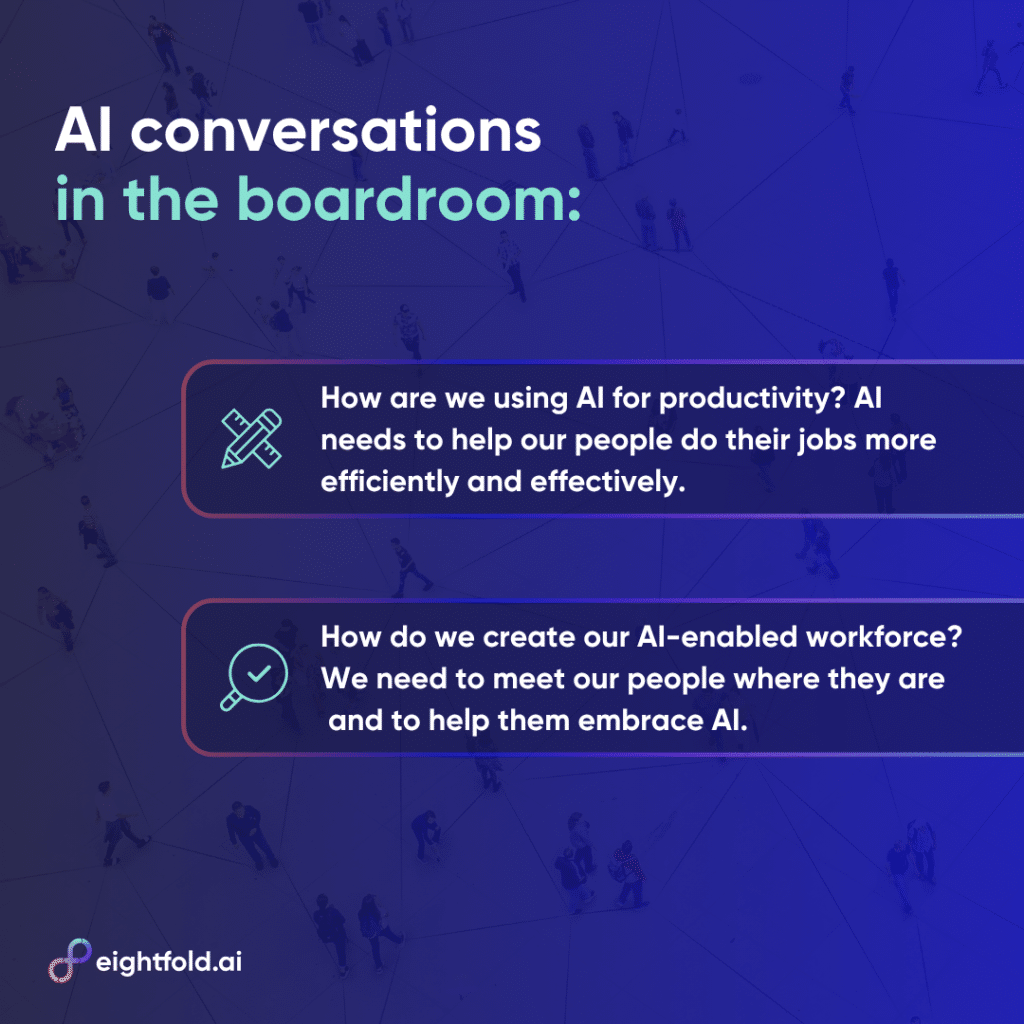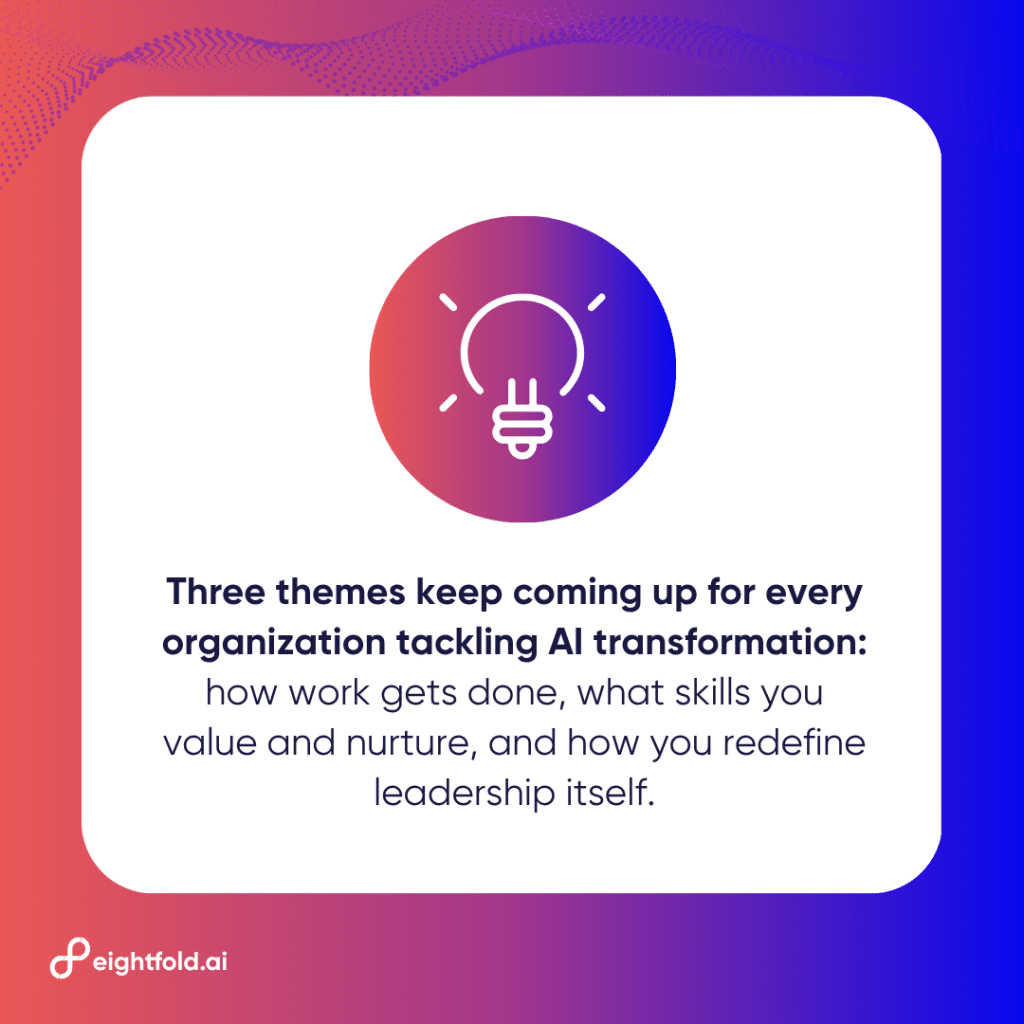- It’s time to rethink how work is done in your organization. AI requires evolving structures where empowered teams flow to where they add value, not traditional hierarchies with slow decision-making and siloed teams.
- Curiosity, learning agility, adaptability, and collaboration are your competitive advantages while AI handles routine tasks.
- As HR leaders, you must become change experts and growth drivers by championing AI that helps people do their work better through partnerships with your CIO.
We’re living through one of the most fascinating eras in how work gets done.
Every week brings new stories about AI — some that spark excitement about what’s possible, others that raise important questions about what it all means for our teams and our roles as leaders. The conversations are everywhere, from boardrooms to break rooms, with no signs of slowing down.
In every leadership conversation, I ask the same question: where are you leading from — fear or from curiosity?

The questions leaders are actually asking
Through many conversations, I’ve learned that leaders want to know two things.
First, how is AI going to make your people more productive, and how are you helping them adapt?
Second, how do you transform from a traditional workforce to an AI-enabled one where AI is part of the natural order of work?
These aren’t technology questions — these are leadership questions. And the questions start with you in HR.
At Eightfold, we live this transformation from two sides. We’re a technology company helping organizations navigate workforce transformation with AI, and we’re an employer going through our own transformation, applying the same principles internally.
That duality makes this real for us. We’re both teachers and practitioners.
When I joined Eightfold, I had to ask myself a hard question: am I going to lead this AI-first company with curiosity or fear?
That question has guided every decision since.

3 lessons from leading with curiosity
From that mindset, I’ve learned a series of lessons drawn from what I’ve seen across customers, advisers, and our journey. Three themes keep coming up for every organization tackling AI transformation:
- How your work gets done.
- What skills you value and nurture.
- How you redefine leadership itself.
1. Reengineering how work gets done
As we think about the future of work, we need to take a step back and think about how work really happens in organizations. What are the processes that cut cross-functionally? What items can be done by AI vs. humans? Then we must reengineer the process to integrate both agents and humans in everyday workflows to get things done more effectively.
If you think this kind of change can’t happen in large, complex, or regulated companies, think again.
Bayer, a 162-year-old pharmaceutical company, is actively reimagining its organization with our help. The company has moved from a traditional hierarchy of silos and slow decision-making to a model called Dynamic Shared Ownership, which empowers customer-centric networks of teams that flow to where they can add the most value.
This is what AI-enabled agility can look like — and it starts with culture.
2. Skills that matter in the AI era
As structure changes, so do the skills that matter. The differentiators in an AI-first world are deeply human: curiosity, learning agility, adaptability, collaboration, and risk-taking. When nurtured, these are the skills that make AI an accelerator, not a threat.
Salesforce’s Career Mosaic shows this in action. The CRM software company uses AI to make internal career paths visible and actionable. Since Q1 of this year, 51% of Salesforce hires were internal transfers.
How? AI is surfacing unexpected career paths so Salesforce employees discover opportunities they hadn’t imagined before.
The result: an increase in internal mobility and reduced external hiring costs. When people can see their future inside their current company, they stop looking outside.
3. HR’s new remit
All of this redefines what HR leadership looks like. You’re no longer administrators or policy enforcers. You’re psychologists, transformation experts, coaches, consultants, and business partners.
HR is a growth engine — driving productivity, innovation, and adaptability.
You have to be the ones championing useful and responsible AI that helps people do better work. Because if you don’t, someone else will fill that space.

How to lead differently
So how do you lead differently in an AI-driven world? These principles guide me:
- Lead with curiosity, not caution. Treat AI as a leadership muscle to build, not a compliance box to check. Get hands-on and experiment with AI tools yourself — fluency builds both credibility and empathy.
- Co-create, don’t just react. Partner with your business leaders — CIOs, CTOs, and beyond — to design the future of work together. They know technology; you know people. True transformation happens when both come together. You also own a seat at the table.
- Rewire culture, not just process. Make learning and experimentation the new cultural norms. Celebrate AI wins — big or small — and reward progress over perfection.
- Keep humanity at the center. Technology should amplify purpose, not replace it. People don’t join companies for tools — they join for meaning, growth, and connection. Let AI clear the noise so humans can focus on what truly matters: creativity, collaboration, and impact.
This is how you move from fear to curiosity, from change management to true leadership.
The question isn’t whether AI will transform work. It’s whether you’ll lead that transformation with courage and imagination, or let it happen to you.
I choose curiosity.
Curious about agentic AI and talent intelligence? Book a demo and learn more about Eightfold.
Meghna Punhani is Chief People Officer at Eightfold AI.
